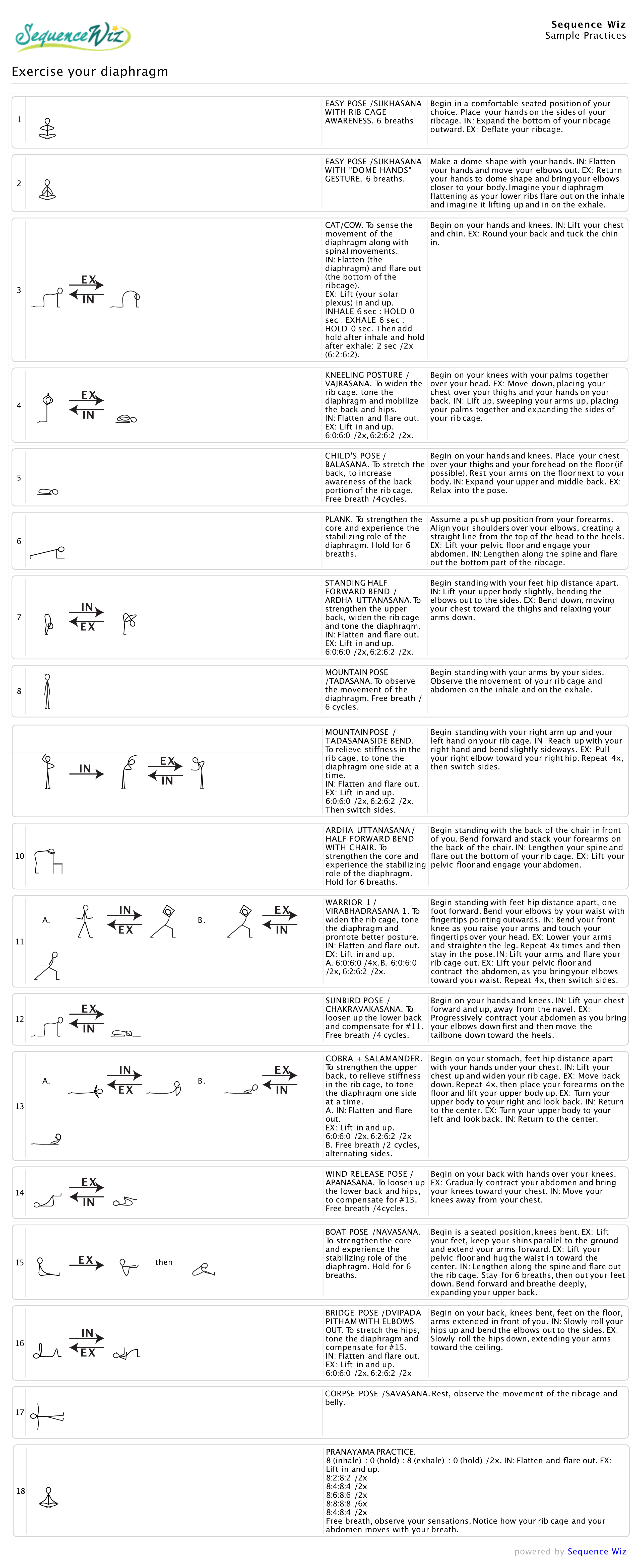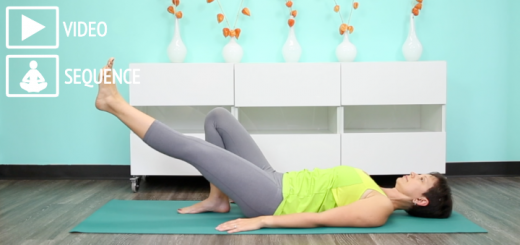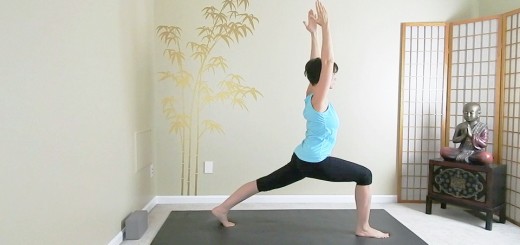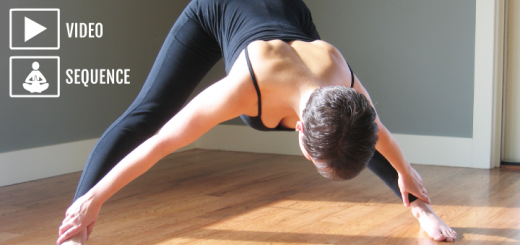Exercise your diaphragm yoga practice
10Your diaphragm is the primary muscle of respiration; it contracts like any other muscle and can be controlled voluntarily. It is important for your diaphragm to maintain tonicity, so that it can properly contract and move down on the inhale and then return to its resting shape with ease on the exhale. This ensures proper lung inflation and ongoing visceral massage.
In this yoga practice we will focus on increasing the muscle tone of your diaphragm by:
- Building awareness of diaphragmatic movement. We will try to envision the movement of the diaphragm and facilitate it with the flare-out action of the ribcage on the inhale and solar plexus lifting action on the exhale.
- Practicing progressive abdominal contraction (“zip up” action) with pelvic floor lift in specific postures that require spinal stabilization,
- Working on increasing the range of motion of the diaphragm by gradually lengthening all four parts of the breath (inhale, hold after inhale, exhale and hold after exhale) both during movement and during pranayama practice,
- Releasing stiffness in the ribcage and thoracic spine to facilitate easier rib cage expansion and promote better posture.
A note of caution – please remember that your diaphragm connects your thoracic and abdominal cavities, with your heart sitting just above it and your digestive system right below. As you begin to expand the movement of your diaphragm, you will be venturing deeper into those territories, which means that this work might bring certain stuff up for you, both on the level of emotions and the level of processing and digestion. It might not be wise to begin this kind of work if you are going through a serious emotional upheaval or dealing with ongoing digestive distress. You might want to let things settle down first or begin very slowly and carefully.
In general, never force your breath or hold it beyond your capacity, always engage your muscles gently (more like a hugging action), and stay aware of your body’s feedback during the practice. Remember – this kind of work is subtle and delicate; we cannot muscle our way into it. Please give it a try and let me know what you think!

[jetpack_subscription_form]




















This is a very wonderful practice to tune into breath while moving. Thank you Olga!
WOW says it all.
Totally breath blissed out! Thank you Olga.
This practice is wonderful in that it brings a lot of awareness to the diaphragm. Is it normal to feel some blacking out during the 8s IN- 2s hold etc? I have tried tis practice twice and felt that both times.
Would be very grateful for your comments Olga.
Thank you, Namaste
Hi Anjani, thank you for trying the practice! No, we don’t want any blacking out when you are working with your breath. It sounds like your breath is not ready to go that far at this moment, so you need to pull it back a bit. Do you have this experience during movement or during pranayama? For now I would recommend that you inhale and exhale only for as long as it’s comfortable, with a slight hold of your breath. You might need to move a bit faster than I am guiding and do more repetitions of some poses. In general, if you do this practice again, I would suggest that you make it a very investigative experience to see how exactly your breath is feeling at every stage and never take it to the limit. It simply might not be a good practice for you right now.
Thanks Olga for your feedback. My experience was only during pranayama and I will investigate further just as you suggest. Namaste
Dear Olga, with the breath exploration and diaphragm/nostril breathing you have given me exactly what I’ve been searching for to both increase breath capacity and breathe properly. I am so grateful. My husband and I have both done this and others of your practices. For my husband, who spends a lot of time swimming/surfing, it was not challenging, but it was very difficult for me. Holding out the breath was by far the most difficult and it made the following inhale difficult to control or lengthen. I believe I read somewhere that it is significant if there is more effort needed on holding the out breath vs in breath but can’t relocate that information yet. Do you know if this is true and what it might suggest? How often would you recommend this sequence for someone like me who finds it difficult and needs to back off throughout? Thanks, as always, Olga, for all you give to us.
Hi Mindy, thank you for your comment! Breath is a remarkable thing and it tends to reflect our physiological state. Theoretically, holding the breath out is supposed to calm the system down, but we know that it’s not often the case. There are several reasons why this might be happening. With every inhalation your sympathetic system (fight-or-flight) gets slightly activated, and with exhalation your parasympathetic system (rest-and-digest) gets activated. I personally find that at times of my life when I find myself spending longer stretches of time in sympathetic activation (like when I am stressed), it becomes harder to tolerate holds after exhale. Another reason might be your system’s CO2 tolerance, which we will talk about in a couple of weeks. There might be other reasons, too. In terms of solutions, there are couple of ways to approach it. 1. You can practice exhaling softly at any point during the day and resting there at the end of your exhalation for few seconds without force. As soon as you feel air hunger, inhale. Overtime, this trains your body and brain to be comfortable in that space of no breath. 2. In your yoga practice, I find it very effective to work with Segmented exhalation – it helps to lengthen your exhale and introduce slight pauses into it. Try this short yoga practice and see how it feels. I hope this helps, and thank you for giving me some ideas for the next post – I think this topic is an important one to explore!
I always enjoy your articles and learn much. I did this practice twice. When doing standing poses, do you ever exhale up and inhale down? That seems to keep to the idea of the ribs flaring out as the diaphragm desending on the inhale and rising on the exhale. I added in agni sara for getting the pelvis muscles moving on the exhale and cleansing breath while standing in a slight backbend with hands laced behind the head.
Hi Anita, thank you for your comment! We will have a separate conversation about when we inhale and exhale with movement in couple of weeks, I hope you find it useful! I am glad to hear that you added your own personal touches to the practice!